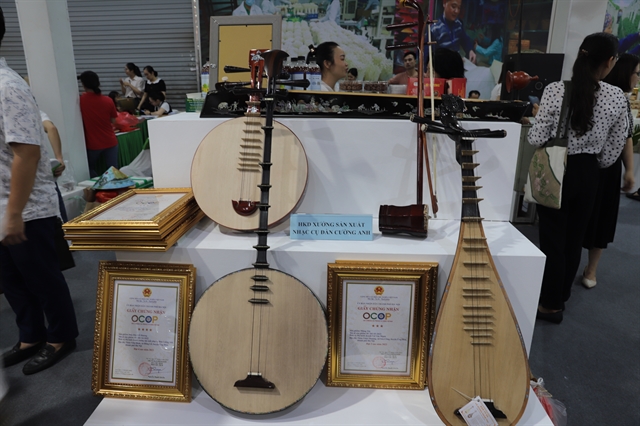Weather:
- Ha Noi 18oC
- Da Nang 21oC
- Ho Chi Minh 27oC

About 50km from central Hà Nội, lies Đào Xá, an iconic village in northern Việt Nam, where its inhabitants primarily rely on rice farming for their livelihoods. However, what remains largely unknown is the village's unique craft – making traditional musical instruments.
As soon as visitors arrive at Đào Xá, located in Đông Lỗ Commune, Ứng Hòa District, they are immediately greeted by the scent of wood and the faint echoes of melodies from the strings of musical instruments being crafted by the local artisans.
The village is now home to five workshops producing many types of traditional musical instruments, which are wholesaled to music stores in the city, as well as fulfilling custom orders for special gifts or even exporting them abroad. Their most typical products are monochord, moon shaped-lute, four-string lute, three-string lute, zither, and two-string fiddle.
However, the esteemed titles of National Folk Artisan and Hà Nội’s Excellent Artisan have been bestowed upon only one man, Đào Văn Soạn, who has been recognised for his exceptional craftsmanship in making traditional musical instruments. Currently, Soạn has been passing down his craft to his son, son-in-law, and a group of young apprentices who are studying at his workshop.
Soạn, with over 40 years of experience, thoroughly understands the ups and downs that the craft of his hometown has been through.
According to him, the instrument making craft in Đào Xá Village traces its roots back over 200 years to the founding efforts of villager Đào Xuân Lan. In the mid-19th century, many skilful workers of Đào Xá, along with their families and relatives, migrated to Thăng Long (present-day Hà Nội) to establish a craft guild, giving rise to the famous Hàng Đàn Street among the 36 ancient streets and guilds of Hà Nội.

With diligence and skilful craftsmanship, the musical instrument makers of Đào Xá created exquisite products to supply the royal court, contributing to the prosperity of their guild. Over the course of time, the craft continued to flourish.
The whole village proudly honoured Đào Xuân Lan as the founder of the craft. They built the Craft Founder's Temple, serving as a place of worship and reverence. Each year, on the ancestral anniversary day, the villagers gather there to pay homage, offering prayers and burning incense to honour those who contributed to the establishment and development of the craft village.
In the 1990s, thanks to the Government's policies of revitalising traditional culture, the craft of instrument making in Đào Xá experienced significant growth. The village saw a surge in the number of households engaged in the craft, with over 50 families involved during that time.
The musical instrument makers must have a profound understanding of woodworking, in addition to keen ears and discerning eyes, according to Đào Văn Tuấn, artisan Đào Văn Soạn’s son.
“From the process of selecting and preparing the wood, to the meticulous steps of shaping, assembling, covering with python skin, polishing, refining, inlaying mother-of-pearl, and finalising, all stages are meticulously done by hand.
“However, the most challenging aspect lies in achieving the desired sound quality. The craftsmen must possess both the skills to fine-tune the instrument and the ability to discern and refine the sound, ensuring that the final product meets the highest standards,” he said.
Interestingly, though the village is where the majority of folk musical instruments are produced, local craftsmen do not receive any formal training in music. Instead, they rely on the inherited knowledge of sound refinement techniques passed down from their ancestors to make the instruments with distinct tonal qualities. Many musicians from various provinces even travel to the village to place orders. Some foreign artists also seek out Đào Xá Village to purchase instruments, highlighting the reputation and demand for their products.
Recently, in an effort to preserve and promote the traditional craft in Đào Xá Village, the People's Committee of Hà Nội has made a decision to officially recognise seven products of the village having achieved four-star OCOP (One Commune One Product) rating, indicating their high quality and craftsmanship at the city level.
These products include the monochord made of ebony wood with inlaid mother-of-pearl, plucked lute made of rosewood, moon-shaped lute made of ebony wood with inlaid mother-of-pearl, four-string lute made of rosewood with inlaid mother-of-pearl, zither made of rosewood with inlaid mother-of-pearl, three-string banjo made of rosewood and two-string fiddle made of rosewood.
Dương Minh Cường of the Cường Anh Musical Instrument Workshop said: "Đông Lỗ Commune is renowned for its craftsmanship in making traditional musical instruments. In my family, I am the third generation continuing the traditional trade. Currently, our family-owned workshop employs 16 workers and produces thousands of instruments each year. Our products are ordered and consumed by musical instrument stores both at home and abroad."

The craft of musical instrument making in the village is not only a means of livelihood but also a distinctive cultural heritage passed down from their ancestors, according to Nguyễn Văn Chí, director of the Rural Development Division under the Department of Agriculture and Rural Development of Hà Nội,
“Amidst the bustling and dynamic sounds of a rapidly changing society, the craftsmen of Đào Xá Village are still keeping the flame of passion and dedication to contribute to the preservation of the essence of the traditional craft,” he said. VNS


